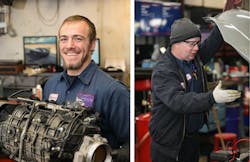SHOP STATS: Stang Auto Tech Location: Broomfield, Colo. Operator: Robert Blaes Average Monthly Car Count: 220 Staff Size: 9 Shop Size: 3,000 square feet Annual Revenue: $1.3 million
Setting goals for your business is not only recommended, but essential in helping your business grow. And if you aren’t sure what your business goals are, how do you expect growth to happen? [See what Elite Pro Service coach Jim Murphy has to say about the importance of setting business goals]
While having your own set of goals is essential, it’s also important for you to help your employees identify their own goals, too. Why? Just ask Robert Blaes, owner of Stang Auto Tech in Broomfield, Colo. Since he’s incorporated employee goal-setting plans into his shop’s culture, it’s helped him retain long-term employees and increase productivity. Since starting this, his shop’s productivity has hit 145 percent and his average employee tenure is roughly five years.
“It’s the owner’s job to set the table for technicians,” Blaes says, which is a motto he uses from Parkway Automotive owner, Mike Davidson, who’s in his 20 Group.
“Are we empowering them to do the things they need to do?” Blaes says. “If we take care of employees, they will take care of customers and take care of you.”
The Backstory
For the past 20 years, Blaes has worked with Elite coach Jim Murphy on his business practices. Every year, Murphy requires the shop owners he works with to send him their yearly goals, with each needing to be extensive and justified.
“He looks at them and the KPIs and that’s what he used to set enabling objectives,” Blaes says.
Blaes says every year at the Pro Service Leadership Conference held in January, shop owners have to go through their goals. Blaes says he’s taken bits and pieces of everything he’s learned and applied those tips to his shop’s processes. One tip he didn’t implement right away, however, was goal setting with his employees. Why?
“In the old days, the unemployment rate was a little higher and people really valued their jobs,” Blaes says. “As long as you got along with your boss and everything was okay, people felt like they had to keep their jobs.”
The Problem
In 2015, the shop had a hard time finding workers and employee turnover made it worse. The growing millennial workforce did not make it any easier for him.
"If you’re not satisfying the stuff in their personal life, it doesn’t matter how much you pay them,” Blaes says. “They will find another place to work.”
Blaes says they didn't have the right people in the right seat, and he needed to find a solution. One of the ways to do this was to appeal to the up-and-coming millennial workforce.
In 2016, he did a complete overhaul of his staff, keeping only two employees due to a problem with not having the right employees with the right skill sets and started fresh. With doing that, he wanted to find techs with certain skill sets and place them in positions where they could excel and a culture that would allow his new staff to thrive.
The Solution
In order to create a positive and employee-driven culture, Blaes decided to restructure the way he gave employee feedback, including a restructuring of how he did employee reviews and conducting annual goal setting meetings, which gives employees a chance to create their own goals.
Blaes gives employees two different ways to reach their goals. One option is with SMART (Specific, Measurable, Attainable, Relative, Time-Based) goals. The other option is a more in-depth program that Elite CEO Bob Cooper crafted. Cooper’s program talks about having a mission statement, long-term, mid-term, and short-term goals in addition to SMART goals.
If an employee chooses the second path, they have to pick a set of core values or a mission statement and answer why they picked it. Then, employees create their own SMART goals that align with those values. If they just want to take the easy route, they go straight into creating their SMART goals. With these goals, Blaes then helps them create a plan and gives employees all of the tools to help them achieve those goals.
“We try to tailor our programs to each employee,” Blaes says. “Some of the goals we see are that some techs want to grow in their career and make more money, so we help them make a plan to get there.”
For example, Blaes says one technician’s goal was to learn how to use a PicoScope, so the shop bought one and Blaes is implementing training on how to use it.
Once those goals are set, Blaes will either meet with his employees weekly or two to three times per week to talk about how they are doing on their goal setting process. Blaes is flexible to what the employees need and it’s not always a formal meeting. Overall, owners just really need to listen to what employees are looking for to get the long-term employees they want.
The Aftermath
Since putting the focus on enhancing the shop’s culture and environment, he says he’s noticed that it’s helped refine their work processes, productivity, and customer loyalty. By giving employees more of a say in their roles and their future, Blaes says it’s improved business overall. Employees started recognizing that to get more hours, their goals would help guide them in what they needed to do. The more hours they get, the more they make.
And since changing up the shop’s culture, the number of loyal customers rose from in the low 500s to mid 800s. Customers now feel like employees care about their job and they are actively involved in meeting customers’ needs.
“When they are meeting their goals, it helps them become more customer-centric,” Blaes says. “It ends up increasing customer satisfaction and we all get rewarded as an end result.”
And even with the technician shortage hanging over every shop owner’s head, Blaes says he still has people coming in and wanting to come work at his shop when they’re fully staffed, all because of what they’ve heard about the culture.
The Takeaway
The biggest advice Blaes has for shop owners looking to enhance their culture is to lead by example, sharing all of his goals with his employees so they know he’s also setting goals and how he’s going about accomplishing them.
Blaes says the goal-setting process is a lot like marketing: owners shouldn’t market with coupons, and should focus on how to provide more value to the customer and the community. Blaes says owners have to do the same thing with their employees.

